Managers across all industries are struggling to get their teams to work together effectively. It can take between 4.6 and 8.5 months for a group to start to function as a team, and according to some studies, 81% of managers say that their team is not operating at anywhere near its full potential.
What can you do to set your team up for success?
In this article, we'll explore 7 key elements of building software development teams. We'll look at what it takes to build a high-performing and resilient team who enthusiastically embraces shared goals.
- 1. Structure your engineering team for the project
- 2. Cover design, engineering, and product roles
- 3. Hire the right people for your software development team
- 4. Provide tools and a good work environment for your team
- 5. Make an effort to improve team communication
- 6. Empower team ownership
- 7. Hold teams accountable
- Conclusion
Structure your engineering team for the project
You need a team to start a software project and bring it to life. So, what do you do? Gather people that are capable of doing the job and kickoff of your project! Sounds easy. If only it were that easy…
The reality is that putting together a successful development team is difficult. You need to thoroughly understand the project at hand and carefully select software engineers, a project manager, and others who will be able to fulfill the project goals.
So, first let’s talk about your software development team structure.
The primary aim of your software development team structure should be to balance trade-offs and maximize the effectiveness of your team. Each team member should have valuable contributions that will augment the skills and assistance of the other team members. Most software development teams fall into one of three categories:
- Technology team (Specialists)
- Product team (Generalists)
- Matrix team
Each of these team structures has its own characteristics - some of which will undoubtedly work better for some teams over others.
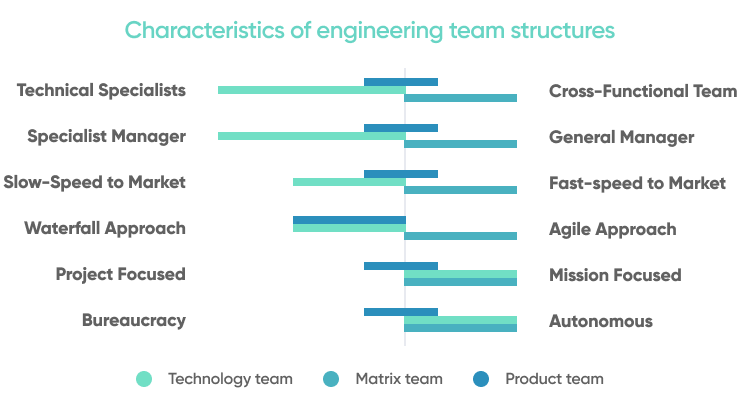
For example, as you can see above, if your team has a general manager (someone who doesn’t have deep technical expertise in just one area), a matrix team may be the best team structure for you. However, a product team works equally well for teams run by general managers and specialist managers, so that could be a good fit as well.
It’s not to say these are absolutes. This is just meant to be a guide to help you think through various aspects of your own team while you learn more about each of the three engineering team structures:
Technology team (Specialists)
A technology team is a team that consists of specialists, typically all focused on one speciality area such as backend development, frontend development, QA testing or perhaps even a specific skill or technology area like Python. These specialists are highly proficient in their chosen field. For example, you might have several software engineers and a key software architect reporting to a project manager or engineering manager, all with a focus on the core technology area.
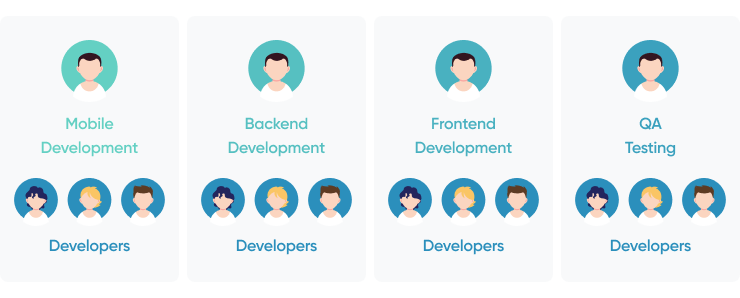
With this software development team structure, the development process is segmented by team. This can make managing software development teams easier if you have managers or project managers who are experts in a particular technology area.
Technology teams can handle specific matters, leveraging their knowledge and expertise, thus resulting in more efficiency and productivity. On the other hand, communication is not really their forte. Being narrow specialists, team members on technology teams may lack the general understanding of how their roles fit into the greater product strategy, which can lead to breakdowns in communication.
When a technology team works well:
- Complex projects that require deep technical expertise: A technology team (or team of specialists) is more suited for projects that require deep technical knowledge in one area.
- Cloud-native projects that need to meet high scalability and availability requirements. If you have a project that requires constant scaling to cater to increasing user base or customers or a project that requires capable hands to be readily available to handle possible issues, your best option is to build a technology team.
Product team (Generalists)
A product team is a team that is - you guessed it - focused around a product. Instead of dividing up the development teams based on expertise in a particular technology area (like Python, QA, or backend development), you divide up the development team by products.
In this way, the focus is on building a software development team that is focused on a product’s success at a high-level rather than simply achieving technical success in one area. These types of teams tend to include talented engineers who are able to work on the full-stack rather than just on one technology area.
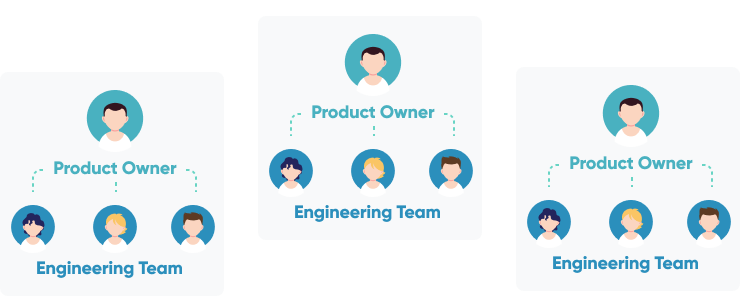
This product team structure helps to bring the full development process onto one single team, managed by a team lead who is skilled at understanding how to connect all of the pieces together to produce a quality software product.
Nevertheless, this structure has its drawbacks as well. Teams may find themselves not capable of delivering if a project requires deep specialized skills and expertise.
When a product team works well:
- End-to-end projects of moderate complexity. If you are running a project that doesn't require (and mostly does not tend to require) specialist knowledge, generalists (or product teams) are the best fit.
- Projects with tight schedules. When the focus needs to be on integrating existing solutions instead of building them, a product team is a great option.
Matrix team
Some situations require a combination of the two team structures above. In such cases, you can have a mix of both team structures. When this occurs, the resulting team structure is called a matrix team.
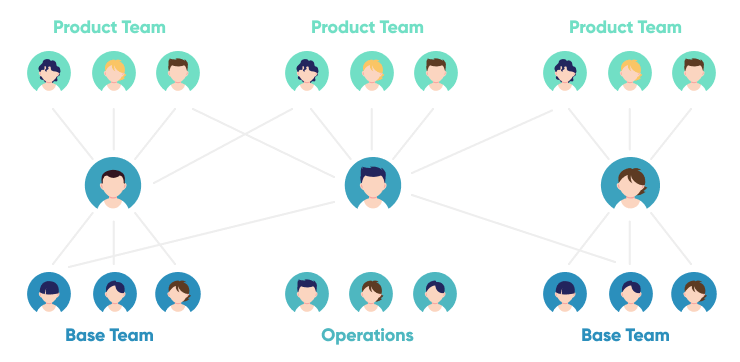
A matrix team allows you to enjoy the benefits of both the technical team structure and product team structure. While the generalists in the team concentrate on actualizing the team's big picture, the specialists on the team can focus on handling implementation that requires deep technical skill.
Managing software development teams like this can be a challenge as the manager will need to understand how to work with specialized software engineers with deep technical skills as well as more business-focused people like a business analyst.
However, this is often a great model for team building as it gives you a balance of the strengths and weaknesses of both the technical and product team structures.
When to choose:
- Projects that require skill or talent sharing across departments. Matrix teams are ideal for ensuring a good share of talent and knowledge across the departments in your organization. It helps you have a team that sees the big picture and the little details, thereby ensuring no stone is left unturned.
- Projects with tight budgets. A matrix approach can be used to build out a small but mighty team capable of completing small to moderate sized projects on a tight budget.
Cover design, engineering, and product roles
After you have decided on the perfect structure to adopt for your new software development team, the next thing for you is to decide on your team's design, engineering, and product roles.
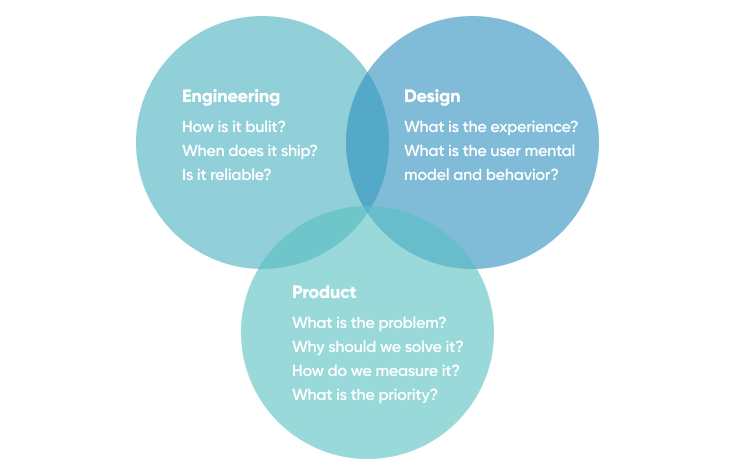
Hire the right people for your software development team
The hiring stage is essential. The quality of each individual team member can make or break the team’s ability to deliver on the project goals. Therefore, you need to ensure you hire the right people for your software development team.
If you want to have a successful software development team, you should consider hiring software developers who are:
Team players above all else
Your software project’s success depends largely on how well your development team communicates and works together collaboratively. You can hire a software developer with strong technical skills but without soft skills and a strong team spirit, you won’t be successful.
Hire people who are not limited to building excellent software. Ensure that they can work well and create excellence as a team - not just individually - but as a team.
Proactive and take responsibility
Software developers who are proactive and take responsibility don't sit and wait for directives. They are always willing and ready to take the initiative to get their job done. They are very responsible, and they make effective plans about their days and tasks to be achieved. That makes it easy for them to integrate into an already successful software engineering team.
Eager to work outside of their comfort zone
Software developers who are eager to work outside of their comfort zone have the ability and drive to learn new things on their own. They are self-starters and are always ready to pick up new skills. They do not shy away from tasks that require them to push beyond their limit. They are never satisfied with their current level and are always looking to find new ways of doing things and new technologies to embrace.
A successful software development team is built one hire at a time. It may be tempting to snatch up the first “good” candidate you interview. But, we encourage you to pause and take your time in the hiring process. It takes time to build a software development team - the process shouldn’t be rushed.
PRO TIP: Consider hiring remotely
Remote working can be advantageous to your organization in many ways:
- It can help you increase productivity while saving you on overhead costs.
- It allows the worker to remove the stress of commuting to work daily while also helping them save money.
- It opens you up to hire top talent from across the globe - not just in your own geographical area.
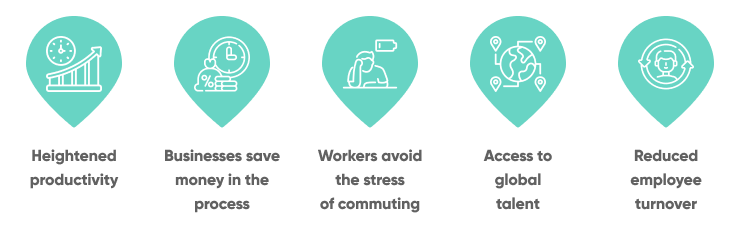
Provide tools and a good work environment for your team
If you want to learn how to build a good software development team - one that continually exceeds expectations and meets deadlines - you need to consider how you, as the manager, are enabling their success. If you want to build an effective software development team, you will need to ensure that you provide them with everything they need to do their job well. This also includes a conducive work environment and every necessary tool to enhance the efficiency and creativity of your software developers.
By prioritizing providing quality technology to your software development teams, you can help to reduce overwhelm and frustration that they may experience if they try to keep themselves organized and productive without the proper tools.
With that in mind, a few tools we recommend investing in if you want to build an effective software development team include:
Source control and continuous integration tools
Gitflow, for example, is a Git workflow that helps your team maintain a continuous development and implementation of your software. These types of tools can improve the efficiency of your software engineering team and make sure that new additions or changes don’t add any code failures.
Furthermore, it allows you to assign specific roles to branches of your team's repositories while defining how and when the branches should interact. That makes it possible for different developers to work at a time while they merge their codes later.
End-to-end automated testing frameworks
End-to-end testing frameworks help your team test the entire application from start to finish. They can also simulate real user scenarios, essentially testing how real users will use the application, which helps to ensure that all integrated parts of the application function as expected and work together.
Automated tests prevent errors and regressions and improve developer productivity. They allow developers to detect problems before moving on to the next task, thereby fixing them while still on the task.
Collaboration and communication tools
SaaS tools like Slack can help to keep your software development team in tight communication with each other as well as other project and development teams.
Providing team members with a tool like this can help to reduce time they spend wading through and replying to emails. Additionally, it can help to maximize productivity by helping your software engineering teams get questions answered before stand up or review meetings take place.
Make an effort to improve team communication
The benefits of effective team communication in the workplace cannot be overstated. Effective communication within the team (whether an in-person, remote, or hybrid team) will help to keep everyone aligned on the team’s common goals, help to facilitate a sense of belonging, strengthen interpersonal relationships, and help developers feel more comfortable reaching out for help or speaking up when they have questions or concerns.
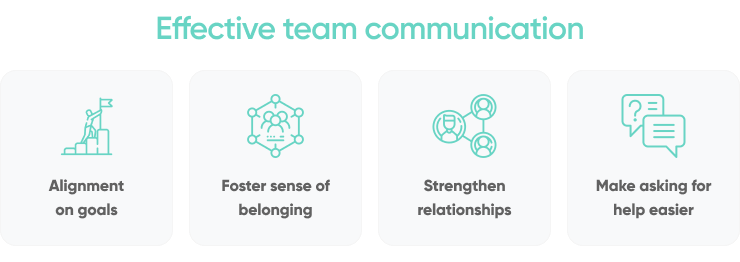
So how can you help to facilitate good communication within your software development teams?
Here are a few tips:
Define roles and goals from the beginning
The more clearly defined the roles of each team member are, the easier it is for them to do their job. In most cases, workplace miscommunication arises as a result of unclear distinctions of roles and responsibilities.
Therefore, to improve the communication on your team and improve their overall productivity levels, it is pertinent that you create well-defined roles, responsibilities, and goals for everyone on the software development team from the very beginning.
This is important regardless of your software development team structure. Successful software development teams of all structures thrive on clarity - and will no doubt flounder when things are undefined. When in doubt, know that overcommunication is better than under-communication.Set a clear path to identify and resolve problems
There will be times when issues will arise among team members and within the team. To ensure that these situations don't escalate into more severe situations, you must set a clear path to identify problems and resolve them immediately when they arise.
Putting a conflict resolution and identification process and path in place for your software development team will ensure that problems are handled effectively when they arise. Take the time to lay out how you expect members of your software development team to handle interpersonal or professional disagreements.
Remember that a successful software development team relies on collaboration. Not everyone has to be best friends, but everyone does need to get along and trust each other to be able to see project success long term.Leverage a common visual language to shrink feedback loops
Waiting until the end of the sprint for feedback is too long. It is best to understand that in software development, minor changes can have a massive effect downstream. For that reason, it’s critical that you provide your software development team with feedback early and often.
Furthermore, if developers do not provide feedback to their peers early, they might make assumptions that can make the project go off-course. The reality is that providing feedback can help to spark conversations about things that may be unclear. The longer it takes for team members to provide feedback, the harder it will be to find possible problems and find solutions.
To ensure feedback loops become as short as possible, create a common visual language that will help develop mutual understanding among everyone on your software development team.
The visual language will facilitate sustained communication and effective coordination, thereby helping your team members make informed decisions to make the project a success.Host retrospective team meetings
Team meetings are necessary for every organization, so of course they are also necessary if you want to build a successful software development team. ITeam meetings are a time for issues, ideas, and observations to be brought to the table. Every team member will give their opinion about the situation and possible steps to take to ensure the project's success.
Depending on your software development team structure, team meetings can also be a good time to loop in your project manager to provide higher-level context on the project.
At the end or project milestones, you should host a retrospective meeting. This meeting is set up to allow your software engineering team to look at their progress so far. You look at each step you've taken to date and how the team’s actions have influenced the project's current state. The retrospective meeting will help you shed more light on actions taken, thereby helping the team make better-informed decisions moving forward in the project.
An effective software development relies on retrospective team meetings to be open and honest about what’s working and what’s not. Celebrate success, but you should also normalize discussing things that didn’t go as planned.Celebrate team successes
Acknowledging your team's successes and celebrating them will help serve as a form of motivation. It enables you to show your team that their efforts do not go unnoticed and that they will be appreciated for their contributions to the project.
Do not underestimate the power of verbal appreciation. Using verbal compliments in public for your team (or team member) will make them feel recognized and appreciated. Similarly, written praise such as sending your software developers emails, can also serve as a good way of celebrating team success. A simple email offering praise to the team members on their achievement will uplift their spirit and make them even more committed to influencing the future behavior and performance of the team.
Keep in mind that providing a communication tool like Slack to all of your developers is only the bare minimum. Your team needs to understand the importance of team communication and the project manager or team lead should be demonstrating appropriate communication skills that the dev team can follow.
Read More: Communication Plan in Project Management [Practical Template]
Empower team ownership
Another key to building software development team success is through empowering your software development team to take ownership over their work. Having a strictly top-down approach to management can wreak havoc on a team and create a situation where only the managers care about the goals of the organization or team. More information in this topic you can find out in our article How to Create Ownership Mentality [with Examples]
Here are a few ways that can help you instill team ownership within your software development team:
Build internal team trust
A software development team that trusts each other will be more likely to collaborate and solve problems internally without management support. In the long run, this can also help to foster a sense of family where the developers see themselves as a vital part of a large family.
To create trust within your team, help your software development team get to know each other's histories, behaviors, and interests. This can start by you sharing some of your own personal interests. What you model will likely be accepted by your software development team.
An effective software development team is comfortable making decisions without management intervention. While of course, your support is critical to your team’s success, you should make it a habit to let your team make crucial decisions internally to help foster a sense of ownership.
Best practices
- Show curiosity and expect the team to ask for help or feedback
- If somebody brings a challenging issue to your attention - encourage taking it to the team for discussion
- Demonstrate vulnerability and admit mistakes
- Make explicit that there are a lot of unknowns with complex work
Provide overall project status updates
The more aware the team members are about the organization's activities, the more they'll feel vital to the team. If they can see how their work is impacting the larger project or company goals, they’ll just naturally feel more invested in its success.
If you want to build a successful software development team, you should look for ways to connect your developers with the larger mission of your organization. Consider bringing in managers from other teams for Q&A sessions or sharing status updates from meetings that your team members weren’t present for.
Providing your team project status updates can help to empower ownership among your team, which will be a win for everyone in the long run!
Best practices
- Reference visual sprint board whenever discussing work with other team members
- Create a user story mapping board where the team can see the user's journey through your product and where we are currently within the larger picture of the product roadmap
- Regularly ask, "How do we feel about our progress towards the Sprint Goal?" and "What do we think is the most important thing for us to focus on and achieve today?
- Work with team to identify where they see waste and bottlenecks by tracking WIP (work-in-progress) and how much time is spent waiting on others
Create a culture of shared responsibility
To empower your team, you need to create a culture where everyone on the team knows that individual success is success for the team. And, likewise, an issue that one person on the software development team is experiencing should be seen as an issue for the whole team to solve.
One way to help facilitate this is to ensure that information is transparent among team members. That will make it easy for team members to discuss their progress, discover possible problems and collectively find solutions to issues that arise.
Best practices
- Change the language to "we succeed as a team" and "we fail as a team."
- Hold individuals accountable by having them present progress on the area they worked on during Sprint demos
- Host resources in a shared location that everyone can access
Hold teams accountable
The more empowered your team is, the more naturally accountable they will be for their work. However, it’s still important for you to hold team’s directly accountable for their work. Doing so can help to ensure everyone is contributing adequately and fulfilling their responsibilities.
Here are a few tips to hold your software development team accountable:
Define what people are accountable for
Team members need to have clearly defined expectations to accomplish their goals. Your organization may have some core responsibilities that align with the mission, core values, and purpose which you want the team to prioritize. Examples of such could be quality, excellence, or customer-centricity.
Other times, you may want your team to be accountable to completing specific tasks or hitting project milestones. Either way, you need to clearly define what each member of your software development team is accountable for.
Being transparent about what you expect from your team will help you build a successful software development team that is self-motivated and resilient.Provide relevant feedback
Your team needs feedback from you to know if they are successfully meeting their goals. Don’t wait until the end of a quarter or the completion of a project to provide feedback. Both positive and constructive feedback can be helpful for developers to receive on an ongoing basis.
While preparing your feedback, ask yourself if you have all of the relevant information and the right data that is focused on performance. You can reinforce positive behaviors with performance-orientated data or discourage the negative ones which can ultimately boost the team’s productivity.
Remember that your team relies on you to help them grow. If you don’t provide feedback, you can’t expect them to invest in their individual growth. Make sure you are adequately rewarding successes and addressing things that you want to change. It all starts with you!Stop the 'hero worship'
A new study conducted by Northwestern University revealed that when team members share previous experiences where they have successfully completed milestones together, the likelihood of winning increases for subsequent projects.
To put this research into practice you can celebrate successes together - rather than simply rewarding one “top performer.” If your software development team can see their shared success, they’ll be more likely to replicate their success in future projects.
The key here is shared success, which is more significant than individual success. As the team leader, you can reinforce purposeful collaboration and harmony by rewarding team-focused goals and not individual wins.
Conclusion
Software development teams can be tricky to build. It’s easy to make mistakes throughout the team formulation stage as well as the ongoing maintenance and facilitation stages. Unfortunately, when mistakes are made, you’ll likely see a hit to your bottom line, or worse yet, catastrophic project failure.
To ensure that you set up the most effective teams possible, employ these vital elements that have been discussed above. They will help you handle the core areas of your team and give the needed structure and strength to your software development team to ensure you have long-term success.
Building your dedicated software engineering team? Our experienced team of engineers, designers, and product leaders can help you accelerate your software development project. Reach out - we're always ready to help!




![AWS Security Incident Response Plan [Practical Guide]](/uploads/aws-security-incident-response-plan.png)


